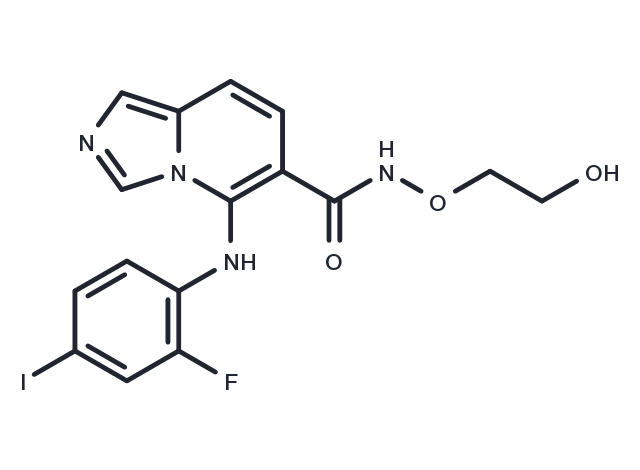Powder: -20°C for 3 years | In solvent: -80°C for 1 year
GDC-0623 (RG 7421) is a potent and ATP-uncompetitive MEK1 inhibitor with Ki of 0.13 nM. Phase 1.

| 説明 | GDC-0623 (RG 7421) is a potent and ATP-uncompetitive MEK1 inhibitor with Ki of 0.13 nM. Phase 1. |
| ターゲット&IC50 | MEK1:0.13 nM(ki) |
| In vitro | AMG 925 shows potent antiproliferation efficacy against U937, MOLM13 and Colo205 cells with IC50 of 52 nM, 19 nM and 55 nM, respectively, and induces cell apoptosis. AMG 925 also inhibits pSTAT5 in MOLM13 and pRb via FLT3 and CDK4 inhibition in Colo205 with IC50 of 0.005 and 0.023 μM, respectively. [1] |
| In vivo | In NCR nude mice bearing MOLM13 tumors, AMG 925 (150 mg/kg, p.o.) inhibits STAT5 phosphorylation, and causes 100% tumor growth inhibition (TGI). [1] In mice bearing Colo205 xenografts, AMG 925 (50 mg/kg, p.o.) inhibits RB phosphorylation, and causes 97% tumor growth inhibition (TGI). [2] |
| キナーゼ試験 | Kinase Assays: The inhibitory activity of FLT3 is determined using a time-resolved fluorescence resonance energy transfer (TR-FRET) assay. An ULight-labeled synthetic peptide (ULight-JAK1, PerkinElmer, Waltham, MA) derived from human Janus kinase 1 (amino acids 1015–1027) is used as the phosphoacceptor substrate. The FLT3 assay is conducted in a 384-well white OptiPlate in a total volume of 20 μL. The reaction mixture contains 50 nM ULight-JAK1, 116 μM ATP (equal to Km), 0.5 nM FLT3, and serially diluted test compounds in a reaction buffer of 50 mM Hepes, pH 7.6, 1 mM EGTA, 10 mM MgCl2, 2 mM DTT, and 0.005% Tween 20. The reaction is allowed to proceed for 1 h at room temperature and stopped by adding 20 μL of 20 mM EDTA and 4 nM LANCE Eu-W1024 antiphospho-tyrosine antibody in LANCE detection buffer. The plates are incubated at room temperature for 2 h after addition of detection reagents and are then read on an Envision multimode reader. Fluorescence signals measured at 615 nm (8.5 nm bandwidth) and 665 nm (7.5 nm bandwidth) with a 60 μs delay after excitation at 320 nm (75 nm bandwidth). The signal ratio at 665/615 nm (APC/Eu) was used in all data analyses. For CDK4 and CDK6 kinase assays, Rb (amino acids 773–928), and histone H1 are used as substrate for CDK4/6 and CDK1/2, respectively. Assays are performed in 96-well filter plates with a final volume of 100 μL, containing 1 μg Rb, 25 ng CDK4/cyclin D1, 25 μM ATP, 1 μCi [r-33P]-ATP, and compound in kinase reaction buffer (20 mM Tris-HCl, pH 7.4, 10 mM magnesium chloride, 5 mM β-glycerophosphate, 1 mM dithiothreitol, and 0.1% bovine serum albumin). Plates with reaction mix are incubated at room temperature for 60 min, and reactions are terminated by addition of 200 μL of 20% trichloroacetic acid. Wells are washed with 200 μL of 10% trichloroacetic acid and left to dry at room temperature. The bottom of the plates is sealed with tape, and 100 μL of MicroScint-20 scintillation cocktail are added to each well.Plates are read on a TopCount to determine radioactive incorporation. IC50 values are calculated by nonlinear regression curve fitting using GraphPad Prism v5.01. |
| 細胞研究 | Cell growth is measured by a DNA synthesis assay. Cells are seeded in a 96-well Cytostar T plate at a density of 5 × 103 cells/well in a total volume of 160 μL. The plates are incubated overnight to allow cells to attach. Test compounds are serially diluted into the plate (20 μL/well), and 20 μL/0.1 μCi of [14C]-thymidine are added to each well. Isotope incorporation is determined using a β plate counter after a further 72 h. IC50 values are determined by nonlinear regression curve fitting using GraphPad Prism v5.01.(Only for Reference) |
| 別名 | G-868, GDC0623, RG 7421, MEK inhibitor 1 |
| 分子量 | 456.21 |
| 分子式 | C16H14FIN4O3 |
| CAS No. | 1168091-68-6 |
Powder: -20°C for 3 years | In solvent: -80°C for 1 year
H2O: < 1 mg/mL (insoluble or slightly soluble)
Ethanol: 5 mg/mL(11 mM)
DMSO: 91 mg/mL(198.82 mM), Heating is recommended.
You can also refer to dose conversion for different animals. 詳細
bottom
Please see Inhibitor Handling Instructions for more frequently ask questions. Topics include: how to prepare stock solutions, how to store products, and cautions on cell-based assays & animal experiments, etc.
GDC-0623 1168091-68-6 Apoptosis MAPK MEK G-868 G 868 Mitogen-activated protein kinase kinase GDC 0623 GDC0623 inhibit Inhibitor MAP2K MAPKK MEK inhibitor1 G868 RG 7421 MEK inhibitor-1 RG-7421 RG7421 MEK inhibitor 1 inhibitor
